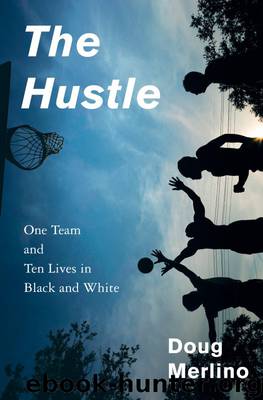The Hustle: One Team and Ten Lives in Black and White by Merlino Doug

Author:Merlino, Doug [Merlino, Doug]
Language: eng
Format: epub
Tags: Biography
ISBN: 9781608192595
Barnesnoble:
Goodreads: 9316548
Publisher: Bloomsbury USA
Published: 2010-12-21T00:00:00+00:00
The implications of gentrification on what was once a geographically cohesive black community can be glimpsed on Sundays. One day, when I attend Mount Zion Church, the large, gravel parking lot is perhaps a quarter full. Inside, a few hundred people sway to the gospel choir. Samuel McKinney, now pastor emeritus, sits in a pew next to his wife. The congregation, almost all black, is well dressed. The average age looks to be about sixty.
At the same time, twenty miles to the southeast, between the towns of Renton and Kent, the Reverend Leslie Braxton preaches to a younger flock at the New Beginnings Christian Fellowship. In 1999, Braxton, who is African American, had become pastor of Mount Zion after McKinney’s retirement. Six years later, members of the church began a drive to have him removed; when they listed their complaints, they objected to everything from his sermons to his leadership style. Braxton left and founded New Beginnings, taking several hundred of Mount Zion’s members with him. Striking out in a different direction, Braxton has embraced the racial mix of the new suburbs, hiring a white executive pastor—the person who runs the church’s daily operations—and making a special effort to reach out to mixed-race couples as well as the area’s growing Hispanic and Asian populations. The church, as he sees it, has to embrace the new reality—it can no longer afford to be an exclusively black institution in what is becoming an increasingly jumbled culture.
The two churches straddle a generational fault line: on one side, an older black population that commutes back to the Central Area to maintain its tradition; on the other, a younger one moving on to a future in the suburbs that now surround a wealthier, more exclusive city. Looking at it over the course of decades, the move to Seattle’s southern suburbs is another step in the still-unfinished black migration from the South, with the grandchildren of African Americans who came up in the 1950s and 1960s exiting the city, pushed by economic factors as their elders once were from places such as Louisiana and Mississippi.
When white people talk about the gentrification of the Central Area, a common refrain is, “It’s not race, it’s economics.” “People wanted to sell and move to the ’burbs,” the developer seeking to buy DeCharlene Williams’s property tells me. If anything, he says, Williams just “hates” that white people are moving in. “A lot of black people think there’s a conspiracy to freeze people out,” he says. “That might have been the case thirty years ago. If anything, it’s the opposite now.”
Of course, for many black people, thirty years is not that long ago. They remember when the Central Area was left to fester—black homeowners were unable to get loans, their children had to attend substandard schools, and racial discrimination in employment was open and obvious. Those factors created the depressed real estate prices in the Central Area that developers, now that the neighborhood is seen as a desirable place to live, have capitalized on.
Download
This site does not store any files on its server. We only index and link to content provided by other sites. Please contact the content providers to delete copyright contents if any and email us, we'll remove relevant links or contents immediately.
Imperfect by Sanjay Manjrekar(5750)
Wiseguy by Nicholas Pileggi(5618)
The Body: A Guide for Occupants by Bill Bryson(4893)
Tuesdays with Morrie by Mitch Albom(4607)
Unstoppable by Maria Sharapova(3441)
Not a Diet Book by James Smith(3302)
Crazy Is My Superpower by A.J. Mendez Brooks(3277)
Into Thin Air by Jon Krakauer(3268)
The Mamba Mentality by Kobe Bryant(3155)
The Fight by Norman Mailer(2808)
Finding Gobi by Dion Leonard(2725)
Tuesdays With Morrie by Mitch Albom(2636)
The Ogre by Doug Scott(2606)
My Turn by Johan Cruyff(2532)
Unstoppable: My Life So Far by Maria Sharapova(2423)
Accepted by Pat Patterson(2272)
Everest the Cruel Way by Joe Tasker(2214)
Open Book by Jessica Simpson(2185)
Borders by unknow(2152)
